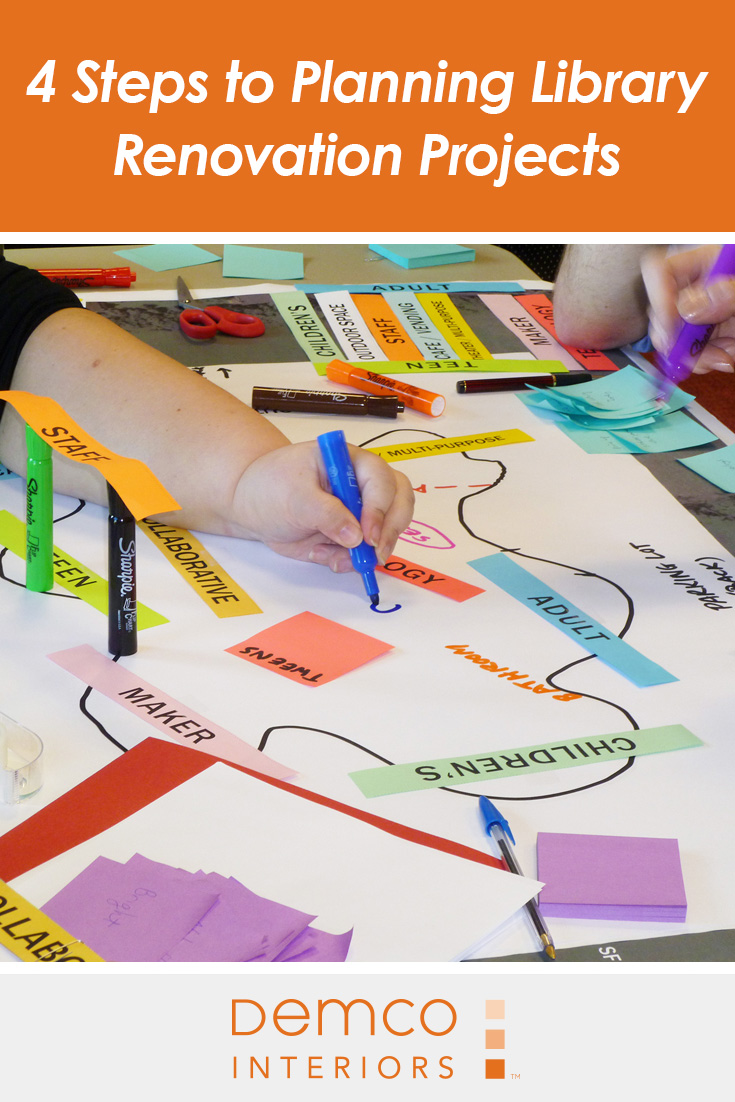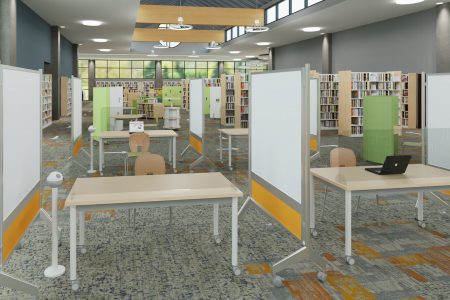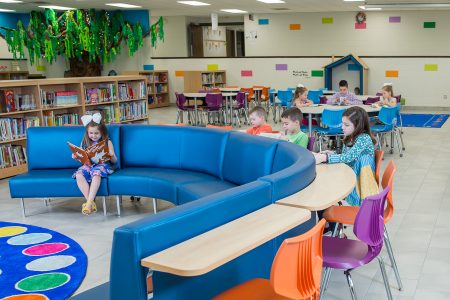Your community is always evolving, and so are the needs of its members. As you continue to provide valuable services, you may wish to make some changes to your spaces and your building’s infrastructure to better accommodate those needs. But what’s the best place to start with a renovation project?
 1. Get to Know Your Space
1. Get to Know Your Space
When creating a plan or vision for your library, start by arming yourself with information. Dig up any details you have about your building, including floor plans and other construction documents.
Next, create an evaluation team. Your team should consist of various staff and facilities personnel who are excited to collaborate and try new things. Have each member start contributing to an idea kit, sharing articles, trends, photographs, furniture, public spaces — anything that you think would be of value to your community and your library.
This is the time to think big and not worry about what can or can’t be done.
Then, make copies of your floor plans, and send each member of your evaluation team out to review each area of the library. Direct them to use markers to make notes on the plans about possible changes. Tell them to look at your library from both a staff perspective and a patron’s perspective, and question everything.
Questions could include the following:
- How does this space look? Is it inviting, dark, warm, messy, hot, cold, too sunny or overcrowded? What’s the first thing you notice?
- Does this space still work for its intended purpose?
- Is it accessible to patrons of all abilities?
- Do patrons still gather in this space? If not, why might that be? Is it lack of power access, poor lighting, not enough seating?
- How can this space be improved? Should it be combined with another space? Should it be eliminated?
- Can the space do double-duty as a meeting space if we add a monitor on the wall or glass partitions to an alcove?
- Don’t forget to look up and down. Do the ceiling tiles sag? Are they stained or dirty? Is the plaster cracking?
- What do the walls look like? Is the paint color stained or dirty?
- What do patrons see when they look around? Is your furniture near a window area with a view?
2. Prioritize the Issues
Once everyone has had a chance to evaluate the different spaces in your library, get back together as a group and compare your findings. Make a list of the issues and ideas and highlight the ones that came up the most. Brainstorm ways you can resolve building issues or improve services.
Start to prioritize your list using the following tactics:
- Discuss: If you emptied everything out of the building, what would you bring back in and where would you put it?
- Label issues as maintenance, repair, or aesthetic.
- Think about the flow of the library and where the staff is most needed.
- If known at this point, write down estimates for different projects.
 Then, using your ideas as a starting point, go on a field trip as a group and visit libraries that are newly built or renovated.
Then, using your ideas as a starting point, go on a field trip as a group and visit libraries that are newly built or renovated.
Compare their spaces and services to each other, their communities and your own library.
Touch base with the library staff and ask questions about costs for projects and new technologies they’ve added. Talk about what worked and what didn’t work when rolling out their new facilities. Ask their permission to take pictures to add to your notes so you can discuss back at home base.
3. Get Feedback From Your Community
After you have all your notes and thoughts organized and prioritized, it’s time to reach out to your community and get their thoughts, concerns and opinions.  Here are some options you can use when gathering feedback:
Here are some options you can use when gathering feedback:
- Hold a large community meeting.
- Hold smaller focus groups with patrons, teens, parents, homeschoolers, etc.
- Reach out to other community organizations, such as your local Human Services office. They may have access to community members who don’t currently use the library and be able to give insights into much-needed services.
- Place a survey on your website and at the checkout desk.
Review the information and identify the recurring themes in your community’s responses and see how they match up to your team’s vision of the future.
4. Bring It All Together
This entire process should make you more aware of your library and the assets you have, as well as the services you’re providing (or would like to provide). It’s going to be a lot of information, so don’t let it overwhelm you.
Identify the easy fixes and the must-haves (such as replacing stained ceiling tiles, rearranging furniture or making spaces ADA compliant). Prioritize those fixes by cost. If there are a lot of maintenance issues, you might want to consider bringing in a professional to help you prioritize and talk through how they can be addressed. It can be more cost effective if you can choose several key areas for a contractor to work on instead of having them come back multiple times.
Evaluate the projects and decide whether they could be grouped together and done in phases. Figure out if you can target specific spaces for the biggest impact.
For example, Stark County Public Library (OH) was running out of space for their high-demand computer use, so they were able to repurpose a low-traffic area that previously held stacks and tables to add more technology. They were able to save money by using paint to brighten and refresh the space and arranging the furnishings in such a way that they could take advantage of the existing electrical supply.
If you have some larger-ticket items, start brainstorming ways to raise money to make the changes. Gain ideas from 5 Tips for Getting Your Library Renovation Projects Funded, Jennifer Bruneau’s post about the efforts of the Boylston Public Library (MA) to gain community support and funding for their renovation.
And even if you aren’t able to tackle your entire wish list right away, by going through this process, you will have brought together a great team, all of whom are now invested in continuing to pursue updates and enhancements to your library.
Stephanie Shook, LEED AP BD+C, Interior Designer
Stephanie has been with HBM Architects since 2006. Overall, she has more than 20 years of experience in developing interiors for public spaces. With a focus on public and academic libraries, she leads the development and growth of the firm’s interior design department.
Stephanie translates her clients' needs and vision into an exciting, beautiful and highly functional library space that fits the unique context of each community. Her experience includes library programming, planning, design, finish selection, furniture selection, custom cabinetry design and detailing as well as interiors package coordination, construction administration, installation and project management.
With a strong emphasis on sustainability and integration of LEED ideas and components, HBM’s designs include multi-faceted solutions spanning many styles from historic to contemporary and have been recognized by the American Institute of Architects, Association of Licensed Architects, Urban Libraries Council, Library Journal Magazine and American Libraries Magazine for excellence in design.
Latest posts by Stephanie Shook, LEED AP BD+C, Interior Designer (see all)
- Top 5 Library Design Trends - August 27, 2018
- 5 Library Updates You Can Make on a Budget - August 17, 2017
- 4 Steps to Evaluating Your Library for Updates - August 3, 2017
- 9 Ways to Create a Children’s Area That Keeps Kids Coming Back - January 23, 2017






